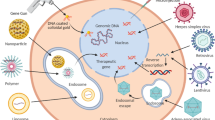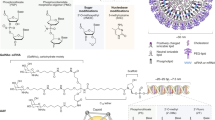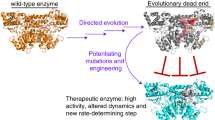Abstract
New techniques now make it feasible to tailor enzymes for cancer gene therapy. Novel enzymes with desired properties can be created and selected from vast libraries of mutants containing random substitutions within catalytic domains. In this review, we first consider genes for the ablation of tumors, namely, genes that have been mutated (or potentially can be mutated) to afford enhanced activation of prodrugs and increased sensitization of tumors to specific chemotherapeutic agents. We then consider genes that have been mutated to provide better protection of normal host tissues, such as bone marrow, against the toxicity of specific chemotherapeutic agents. Expression of the mutant enzyme could render sensitive tissues, such as bone marrow, more resistant to specific cytotoxic agents.
This is a preview of subscription content, access via your institution
Access options
Subscribe to this journal
Receive 12 print issues and online access
$209.00 per year
only $17.42 per issue
Buy this article
- Purchase on Springer Link
- Instant access to full article PDF
Prices may be subject to local taxes which are calculated during checkout

Similar content being viewed by others
References
Skandalis, A., Encell L.P., and Loeb L.A. 1997. Creating novel enzymes by applied molecular evolution. Chem. Biol. 4:889–898.
Loeb, L.A. 1991. Mutator phenotype may be required for multistage carcinogenesis. Cancer Res. 51:3075–3079.
Moolten, F.L. 1994. Drug sensitivity ("suicide") genes for selective cancer chemotherapy. Cancer Gene Ther. 1:279–287.
Moolten, F.L., Wells, J.M., Heyman, R.A., and Evans, R.M. 1990. Lymphoma regression induced by gancyclovir in mice bearing a herpes thymidine kinase transgene. Hum. Gene Ther. 1:125–134.
Dachs, G.U., Dougherty, G.J., Stratford, I.J., and Chaplin, D.J. 1997. Targeting gene therapy to cancer: a review. Oncol. Res. 9:313–325.
Brenner, M.K. 1998. Gene transfer and the treatment of childhood cancer. Cancer Invest. 16:269–278.
Rosenberg, S.A. 1993. Newer approaches to cancer treatment—gene therapy of cancer, pp. 2598–2613, in Cancer: principles and practice of oncology, 4th ed. DeVita, V.T., Jr., Hellman S., and Rosenberg S.A. (eds.). J.B. Lippincott, Philadelphia, PA.
Banerjee, D., Zhao, S.C., Li M.–X., Schweitzer, B.I., Mineishi, S., and Bertino, J.R. 1994. Gene therapy utilizing drug resistance genes: a review. Stem Cells 12:378–385.
Rafferty, J.A., Hickson, I., Chinnasamy, N., Lashford, L.S., Margison, G.P., Dexter, T.M. et al. 1996. Chemoprotection of normal tissues by transfer of drug resistance genes. Cancer Metastasis Rev. 15:365–383.
Elion, G.B. 1980. The chemotherapeutic exploitation of virus–specified enzymes. Adv. Enzyme. Regul. 18:53–66.
Culver, K.W., Ram, Z., Walbridge, S., Ishii, H., Oldfield, E.H., and Blaese, R.M. 1992. In vivo gene transfer with retroviral vector–producer cells for treatment of experimental brain tumors. Science 256:1550–1552.
Black, M.E. and Loeb, L.A. 1993. Identification of important residues within the putative nucleoside binding site of HSV–1 thymidine kinase by random sequence selection: analysis of selected mutants in vitro. Biochemistry 32:11618–11626.
Black, M.E., Newcomb, T.G., Wilson, H.–M.P., and Loeb, L.A. 1996. Creation of drug–specific herpes simplex virus type 1 thymidine kinase mutants for gene therapy. Proc. Natl. Acad. Sci. USA 93:3525–3529.
Pope, I.M., Poston, G.J., and Kinsella, A.R. 1997. The role of the bystander effect in suicide gene therapy. Eur. J. Cancer 33:1005–1016.
Bi, W.L., Parysek, L.M., and Warnick, R. 1993. In vitro evidence that metabolic cooperation is responsible for the bystander effect observed with HSV tk retroviral gene therapy. Hum. Gene. Ther. 4:725–731.
Maze, R., Carney, J.P., Kelley, M.R., Glassner, B.J., Williams, D.A., and Samson, L. 1996. Increasing DNA repair methyltransferase levels via bone marrow stem cell transduction rescues mice from the toxic effects of 1,3–bis(2–cloroethyl)–1–nitrosourea, a chemotherapeutic alkylating agent. Proc. Natl. Acad. Sci. USA 93:206–210.
Mickisch, G.H., Licht, T., Merlino, G.T., Gottesman, M.M., and Pastan, I. 1991. Chemotherapy and chemosensitization of transgenic mice which express the human multidrug resistance gene in bone marrow: efficacy, potency, and toxicity. Cancer Res. 51:5417–5424.
Pegg, A.E., Dolan, M.E., and Moschel, R.C. 1995. Structure, function and inhibition of O6–alkylguanine–DNA alkyltransferase. Prog. Nucleic Acid Res. 51:167–223.
Christians, F.C. and Loeb, L.A. 1996. Novel human DNA alkyltransferases obtained by random substitution and genetic selection in bacteria. Proc. Natl. Acad. Sci. USA 93:6124–6128.
Christians, F.C., Dawson B.J., Coates, M.M., and Loeb, L.A. 1997. Creation of human alkyltransferases resistant to O6–benzylguanine. Cancer Res. 57:2007–2012.
Encell, L.P., Coates, M.M., and Loeb, L.A. 1998. Engineering human DNA alkyltranferases for gene therapy using random sequence mutagenesis. Cancer Res. 58:1013–1020.
Xu–Welliver, M., Kanugula, S., and Pegg, A.E. 1998. Isolation of human O6–alkylguanine–DNA alkyltransferase mutants highly resistant to inactivation by O6–benzylguanine. Cancer Res. 58:1936–1945.
Loktionova, N.A., Xu–Welliver, M., Crone, T., Kanugula, S., and Pegg, A.E. 1999. Mutant forms of O6–alkylguanine–DNA alkyltransfersae protect CHO cells from killing by BCNU plus O6–benzylguanine or O6–8–oxo–benzylguanine. Biochem. Pharmacol. In press.
Davis, B.M., Reese, J.S., Koc, O.N., Lee, K., Schupp, J.E., and Gerson, S.L. 1997. Selection for G156A O6–methylguanine DNA methyltransferase gene–transduced hematopoietic progenitors and protection from lethality in mice treated with O6–benzylguanine and 1,3–bis(2–chloroethyl)–1–nitrosourea. Cancer Res. 57:5093–5099.
Chinnasamy, N., Rafferty, J.A., Hickson, I., Lashford, L.S., Longhurst, S.J., Thatcher, N. et al. (1998) Chemoprotective gene transfer II: multilineage in vivo protection of haemopoiesis against the effects of an antitumour agent by expression of a mutant human O6–alkylguanine–DNA alkyltranferase. Gene Ther. 5:842–847.
Rode, W., Scanlon, K.J., Moroson, B.A., and Bertino, J.R. 1980. Regulation of thymidylate synthetase in mouse leukemia cells (L1210). J. Biol. Chem. 255:1305–1311.
Harrap, K.R., Jackman, A.L., Newell, D.R., Taylor, G.A., Hughes, L.A., and Calvert, A.H. 1989. Thymidylate synthase: a target for anti–cancer drug design. Adv. Enzyme Regul. 29:161–179.
Santi, D.V. and Danenberg, P.V. 1984. Chemistry and biochemistry of folates, pp. 345–398, in Folates and pterins, Blakley, R.L. and Benkovic, S.J. (eds.). Wiley–Interscience, New York, NY.
Grem, J.L. 1990. Fluorinated pyrimidines, pp. 180–224, in Cancer chemotherapy: principles and practice, Chabner, B.A. and Collins, J.M. (eds.). J.B. Lippincott, Philadelphia, PA.
Barbour, K.W., Berger, S.H., and Berger, F.G. 1990. A single amino acid substitution defines a naturally occurring genetic variant of human thymidylate synthase. Mol. Pharmacol. 37:515–518.
Tong, Y., Liu–Chen, X., Erickan–Abali, E.A., Capiaux, G.M., Zhao, S., Banerjee, D. et al. 1998. Isolation and characterization of Thymitaq (AG337) and 5–fluoro–2–deoxyuridylate–resistant mutants of human thymidylate synthase from ethyl methanesulfonate–exposed human sarcoma HT1080 cells. J. Biol. Chem. 273:11611–11618.
Landis, D.M. and Loeb, L.A. 1998. Random sequence mutagenesis and resistance to 5–fluorouridine in human thymidylate synthases. J. Biol. Chem. 273:25809–25817.
Tong, Y., Liu–Chen, X., Ercikan–Abali, E.A., Zhao, S., Banerjee, D., Maley F. et al. 1998. Probing the folate–binding site of human thymidylate synthase by site–directed mutagenesis. J. Biol. Chem. 273:31209–31214.
Haber, D.A., Beverly, S.M., Kiely, M.L., and Schimke, R.T. 1981. Properties of an altered dihydrofolate reductase encoded by amplified genes in cultured mouse fibroblasts. J. Biol. Chem. 256:9501–9510.
Srimatkandala, S., Schweitzer, B.I., Moroson, B.A., Dube, S., and Bertino, J.R. 1989. Amplification of a polymorphic dihydrofolate reductase gene expressing an enzyme with a decreased binding to MTX in a human colon carcinoma cell line HCT–8R4 resistant to this drug. J. Biol. Chem. 264:3524–3528.
McIvor, R.S. and Simonsen, C.C. 1990. Isolation and characterization of a variant dihydrofolate reductase cDNA from the methotrexate resistant murine L5178Y cells. Nucleic Acids Res. 18:7025–7032.
Thillet, J., Absil, J., Stone, S.R., and Pictet, R. 1988. Site directed mutagenesis of mouse dihydrofolate reductase. J. Biol. Chem. 263:12500–12508.
McIvor, R.S. 1996. Drug–resistant dihydrofolate reductases: generation, expression and therapeutic application. Bone Marrow Transplant. 18:S50–S54.
Ercikan–Abali, E.A., Mineishi, S., Tong, Y., Nakahara, S., Waltham, M.C., Banerjee, D. et al. 1996. Active site–directed double mutants of dihydrofolate reductase. Cancer Res. 56:4142–4145.
James, R.I., May, C., Vagt, M.D., Studebaker, R., and McIvor, R. 1997. Transgenic mice expressing the tyr22 variant of murine DHFR: protection of transgenic marrow transplant recipients from lethal doses of methotrexate. Exp. Hematol. 25:1286–1295.
Williams, D.A., Hsieh, K., DeSilva, A., and Mulligan, R.C. 1987. Protection of bone marrow transplant recipients from lethal doses of methotrexate by the generation of methotrexate resistant bone marrow. J. Exp. Med. 166:210–218.
Zhao, S., Li, M.–X., Banerjee, D., Schweitzer, B.I., Gilboa, E., and Bertino, J.R. 1994. Long term protection of recipient mice from lethal doses of methotrexate by marrow infected with a double copy vector retrovirus containing a mutant dihydrofolate reductase. Cancer Gene Ther. 1:27–33.
Zhao, S.–C., Banerjee, D., Mineishi, S., and Bertino, J.R. 1997. Post–transplant methotrexate administration leads to improved curability of mice bearing a mammary tumor transplanted with marrow transduced with a mutant human dihydrofolate reductase cDNA. Hum. Gene Ther. 8:903–909.
Spencer, H.T., Sleep, S.E.H., Rehg, J.E., Blakley, R.L., and Sorrentino, B.P. 1996. A gene therapy strategy for making bone marrow cells resistant to Trimetrexate. Blood 87:2579–2587.
Mineishi, S., Nakahara, S., Takebe, N., Banerjee, D., Zhao, S., and Bertino, J.R. 1997. Co–expression of the herpes simplex virus thymidine kinase gene potentiates methotrexate resistance conferred by transfer of a mutated dihydrofolate reductase gene. Gene Ther. 4:570–576.
Mineishi, S., Nakahara, S., Takebe, N., and Zhao, S. 1998. Purine Salvage rescue by xanthine–guanine phosphoribosyltransferase (XGPRT) potentiates methotrexate resistance conferred by transfer of a mutated dihydrofolate reductase gene. Cancer Gene Ther. 5:144–149.
Gulick, A.M. and Fahl, W.E. 1995. Forced evolution of glutathione S–transferase to create a more efficient drug detoxification enzyme. Proc. Natl. Acad. Sci. USA 92:8140–8144.
Horwitz, M.S. and Loeb, L.A. 1986. Promoters selected from random DNA sequences. Proc. Natl. Acad. Sci. USA 83:7405–7409.
Sweasy, J.B. and Loeb, L.A. 1993. Detection and characterization of mammalian DNA polymerase β mutants by functional complementation in Escherichia coli. Proc. Natl. Acad. Sci. USA 90:4626–4630.
Cadwell, R.C. and Joyce, G.F. 1994. Mutagenic PCR. PCR Meth. Appl., 3:S136–S140.
Stemmer, W.P.C. 1994. Rapid evolution of a protein in vitro by DNA shuffling. Nature 370:389–391.
Zhao, H. and Arnold, F.H. 1997. Functional and nonfunctional mutations distinguished by random recombination of homologous genes. Proc. Natl. Acad. Sci. USA 94:7997–8000.
Guengerich, F.P. 1995. Human cytochrome P450 enzymes, pp. 473–535, in Cytochrome P450: structure, mechanism, and biochemistry, 2nd ed. Ortiz de Montellano, P.R. (ed.). Plenum Press, New York, NY.
Kivisto, K.T., Kroemer, H.K., and Eichelbaum, M. 1995. The role of human cytochrome P450 enzymes in the metabolism of anticancer agents: implications for drug interactions. Br. J. Clin. Pharmacol. 40:523–530.
LeBlanc, G.A. and Waxman, D.J. 1989. Interaction of anticancer drugs with hepatic monooxygenase enzymes. Drug Metab. Rev. 20:395–439.
Chakravarti, D., Ibeanu, G.D., Tano, K., and Mitra S. 1991. Cloning and expression in Escherichia coli of a human cDNA encoding the DNA repair protein N–methylpurine–DNA glycosylase. J. Biol. Chem. 266:15710–15715.
Acknowledgements
We thank the investigators who made unpublished data available for this review. We also thank Ann Blank for helpful comments, and the referee and editors for valuable suggestions for the revised manuscript. L.A.L. is supported by NIH grant CA78885. L.P.E. is supported by a postdoctoral training grant from NIEHS (T32 ES07032), and D.M.L is supported by a medical scientist training grant from NIH NIGMS (5 T32 07266).
Author information
Authors and Affiliations
Corresponding author
Rights and permissions
About this article
Cite this article
Encell, L., Landis, D. & Loeb, L. Improving enzymes for cancer gene therapy. Nat Biotechnol 17, 143–147 (1999). https://doi.org/10.1038/6142
Received:
Accepted:
Issue Date:
DOI: https://doi.org/10.1038/6142



